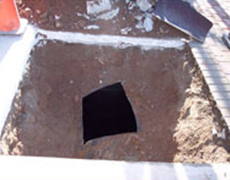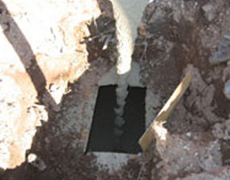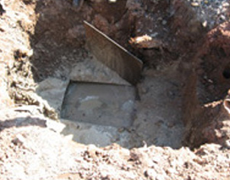Tank Abandonment (Tank Closure in Place)
Norroc recommends that in all cases where it is feasible, the underground storage tank be removed. While this approach is recommended, we know from experience that removal is not always feasible. Tanks can be located in basements or crawl spaces where removal is prohibitive. In these cases a tank closure in place is the preferred option. Petroleum storage tanks once cleaned can be filled with an inert material, such as sand, concrete slurry or foam. The same limitations that can prevent a tank from being removed can also physically hinder the ability to fill a tank with an inert material. The standard ratio of up to five (5) cubic yards of material are required per 1,000 gallons of storage tank capacity. If a tank is located in a physically inaccessible location, the ability to fill the tank with either concrete or sand may be logistically not possible or prohibitively expensive. In these instances foam filling the tank is the most practical option.
The procedures followed to foam fill a tank are as follows:
Step 1: Local Permits
Before any tank closure work can be performed; a permit to abandon the underground tank will be obtained from the local municipality, fire department, health department, or other applicable agency.
Step 2: Excavation
As required by law, Norroc will notify the New Jersey "ONE CALL SYSTEM" to obtain a utility mark out at the subject site. Norrocwill obtain a confirmation number from the "ONE CALL SYSTEM" as verification that the utility mark out was requested. Once notified, if there are public utilities in the area of excavation, the utilities will mark their lines. All on-site work will proceed after all utilities have been marked.
Step 3: Liquid Disposal
Upon arrival to the site and prior to excavation all pumpable liquid product will be removed from the tank and lines. After removal of the tank pumpable liquids, overburden soils will be excavated to expose the top portion of the tank.
 Step 4: Tank Cleaning
Step 4: Tank Cleaning
Uncover the top portion of the tank, cut a hole in the tank. After the tank has been exposed and all the liquids removed, the tank will be purged of petroleum vapors. Continuous atmosphere monitoring of the tank will be performed for flammable vapors and Oxygen content. If no flammable vapors are present and the tank contains sufficient Oxygen, the tank will be entered and cleaned. American Petroleum Institute Publication 2015, "Cleaning Petroleum Storage Tanks," procedures will be followed throughout this phase of the project. Tank cleaning will consist of wiping, squeegeeing, and removing all liquids and sludge from the tank. All liquids and sludge generated as a result of the tank cleaning process will be placed into a vacuum truck and transported off the site under a bill of lading.
 Step 5: Tank Filling
Step 5: Tank Filling
After the tank has been cleaned and inspected by the local official; the tank can be filled with an inert clean material including sand, concrete slurry or foam. The foam is white in color and is classified as an inert nonflammable material.
The foam is installed utilizing a wand similar to a power washer wand connected to garden type hosing. The hose utilized to transfer the foam can be snaked several hundred feet around corners and down stairs to the tank location.
Step 6: Sealing
In addition to cleaning the tank, the outside fill and vent to the tank needs to be sealed so that oil can no longer be delivered to the out of service tank.
The supply and return lines from the tank to the furnace area also need to be cut and capped.
 Soil Sampling Site Assessment
Soil Sampling Site Assessment
Although not typically required, soil samples can be obtained from beneath the invert of the tank by cutting holes through the bottom of the tank.
Norroc recommends abandoning an underground storage tank in place when the tank is located under a building or would endanger a building structure if removed. It should be noted that some townships and municipalities do not allow abandonment in-place. If abandonment in-place is the only option, then soil sampling beneath the tank is highly recommended.
